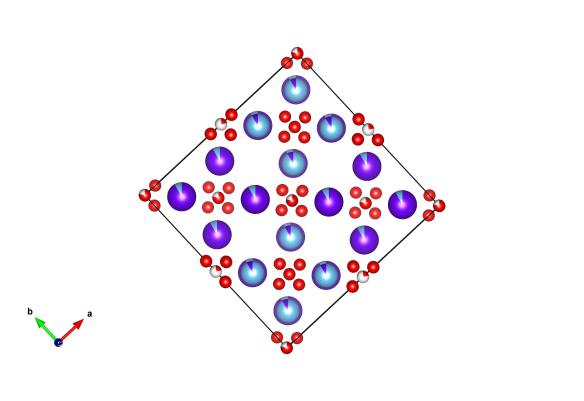Magnetic monopoles in the pyrochlore structure
What does it look like?

The red atoms here are oxygen, and blue are the transition metal with the purple atoms representing the position of the rare earth atoms. Image generated by the VESTA (Visualisation for Electronic and STructural analysis) software http://jp-minerals.org/vesta/en/
What is it?
The pyrochlore crystal structure is a cubic that can be described by the spacegroup Fd-3m. The general formulae for these materials are A2B2O6 and A2B2O7 where the A and B species are typically either rare earth ions, or transition metal species. The A and B sites form an array of interlinked tetrahedra, which are 3 sided shapes consisting of triangles and it is this that often leads to exotic magnetic properties.
Dy2Ti2O7 and Ho2Ti2O7 are two such pyrochlore systems which have been called "spin-ice". This stems from the "2in-2out" magnetic spin structure which can be likened to the water-ice structure where for each oxygen ion, two protons (or hydrogens) must be in the near position and two in the far position. Dy2Ti2O7 and Ho2Ti2O7 are also part of a larger family of geometrically frustrated pyrochlores in which the magnetic "spins" cannot simultaneously satisfy their antiferromagnetic (antiparallel) spin arrangements with all of their neighbouring spins due to the geometric constraints, similar to Jarosite.
![(left) The rare earth tetrahedra structure of the pyrochlore lattice can be used to understand the magnetism in these materials. (right) The “3in-1out” (red) and “1in-3out” (blue) “monopoles” can be seen joined by an infinitely thin Dirac string [Morris et al., Science 326, 411 (2009)].](https://www.iycr2014.org/__data/assets/image/0017/107108/phyrochlores.png)
(left) The rare earth tetrahedral pyrochlore structure can be used to understand the magnetism in these materials. (right) The "3in-1out" (red) and "1in-3out" (blue) "monopoles" can be seen joined by an infinitely thin Dirac string [Morris et al., Science 326, 411 (2009)].
Where did the structure come from?
This crystal structure was taken from van de Velde et al., Powder Diffraction 5 (4), pp. 229-31 (1990) and displays the pyrochlore structure for the related Tb2Ti2O7 material. Each of the A2Ti2O7 materials (A = rare earth) forms a cubic structure with a lattice parameter close to 10 Å.






